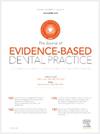THE USAGE AND REPORTING OF DENTAL PATIENT-REPORTED OUTCOMES AMONG SYSTEMATIC REVIEWS IN ORTHODONTICS: A METHODOLOGICAL STUDY
IF 4
4区 医学
Q1 DENTISTRY, ORAL SURGERY & MEDICINE
引用次数: 0
Abstract
Objective
To summarize and analyze the usage and reporting of dental patient-reported outcomes (dPROs) within systematic reviews (SRs) published in 5 leading orthodontic journals between 2015 and 2023.
Methods
A manual search was conducted to identify intervention (therapeutic or preventive) involved SRs published in selected journals between 2015 and 2023 from the official online archives. Two authors independently and in duplicate extracted the characteristics of each included SR, recording both the usage of dPROs in the Methods sections and the reporting of dPROs in the Results sections.
Results
A total of 244 SRs were found eligible and included, of which 81 (33.2%) included dPROs. Out of the 81 SRs, 19 (23.5%) described dPROs in the Methods sections, 6 (7.4%) reported dPROs exclusively in the Results sections, and 56 (69.1%) included dPROs in both sections. In the 75 SRs that stated dPROs in their Methods sections, 38 (50.7%) identified them as primary outcomes, while 37 (49.3%) considered them secondary outcomes. Among the 62 SRs that reported dPROs in the Results section, 17 (27.4%) performed quantitative synthesis, and the remaining 45 (72.6%) conducted only qualitative synthesis. A total of 26 dPROMs were identified, of which only 11 were included in meta-analyses.
Conclusions
Only about one-third of SRs published in leading orthodontic journals included dPROs. It is recommended that researchers consider the usage of dPROs and dPROMs during the design and registration stages of orthodontic SRs and ensure transparent reporting of the results, thus facilitating evidence-based practice and shared decision-making in clinical care.
正畸学系统评价中患者报告结果的使用和报告:一项方法学研究
目的总结和分析2015 - 2023年5家主要正畸期刊发表的系统综述(SRs)中患者报告结果(dPROs)的使用情况和报告情况。方法人工检索2015年至2023年间发表在官方在线档案期刊上的涉及干预(治疗性或预防性)的SRs。两位作者独立地、一式两份提取每个纳入的SR的特征,在方法部分记录dPROs的使用,在结果部分记录dPROs的报告。结果共纳入244例SRs,其中纳入dPROs 81例(33.2%)。在81篇sr中,19篇(23.5%)在方法部分描述了dPROs, 6篇(7.4%)只在结果部分报道了dPROs, 56篇(69.1%)在两个部分都包括dPROs。在75篇研究报告中,有38篇(50.7%)认为其为主要结局,37篇(49.3%)认为其为次要结局。结果部分报道dPROs的62篇ssr中,定量合成的17篇(27.4%),定性合成的45篇(72.6%)。共鉴定出26个dprom,其中只有11个被纳入meta分析。结论仅约三分之一的正畸期刊发表的SRs包含dPROs。建议研究人员在正畸SRs的设计和注册阶段考虑dPROs和dprom的使用,并确保结果的透明报告,从而促进循证实践和临床护理的共同决策。
本文章由计算机程序翻译,如有差异,请以英文原文为准。
求助全文
约1分钟内获得全文
求助全文
来源期刊

Journal of Evidence-Based Dental Practice
DENTISTRY, ORAL SURGERY & MEDICINE-
CiteScore
6.00
自引率
16.70%
发文量
105
审稿时长
28 days
期刊介绍:
The Journal of Evidence-Based Dental Practice presents timely original articles, as well as reviews of articles on the results and outcomes of clinical procedures and treatment. The Journal advocates the use or rejection of a procedure based on solid, clinical evidence found in literature. The Journal''s dynamic operating principles are explicitness in process and objectives, publication of the highest-quality reviews and original articles, and an emphasis on objectivity.
 求助内容:
求助内容: 应助结果提醒方式:
应助结果提醒方式:


